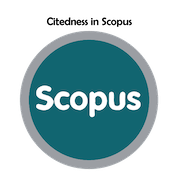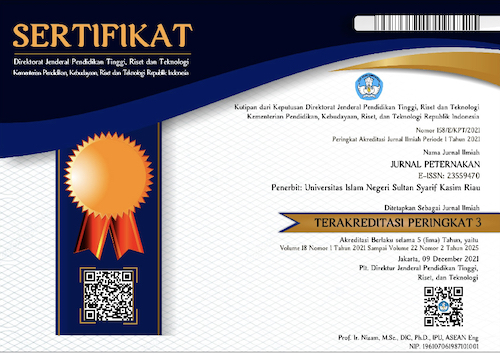Oxidative Stress Status in Heat Shock Sheep Controlled Shearing and Ascorbyl Palmitate Administration
Abstract
Keywords
Full Text:
PDFReferences
Adenkola, A. Y., & Angani, M. T. (2017). Ascorbic Acid Supplementation Effect on Haematology and Oxidative Stress Parameters of Broiler Chicken during the Hot-Dry Season in Southern Guinea Savannah Askorbik Asit İlavesinin Güney Gine Savana ’ da Sıcak -Kurak Mevsimde Broylerlerde Hematolojik ve. Journal of Poultry Research, 14(1): 28–33.
Aktas, M. S., Kandemir, F. M., Kirbas, A., Hanedan, B., & Aydin, M. A. (2017). Evaluation of oxidative stress in sheep infected with Psoroptes ovis using total antioxidant capacity, total oxidant status, and malondialdehyde level. Journal of Veterinary Research (Poland), 61(2): 197–201. https://doi.org/10.1515/jvetres-2017-0025
Al-dawood, A. (2017). Towards heat stress management in small ruminants – a review. 17(1): 59–88. https://doi.org/10.1515/aoas-2016-0068
Bernabucci, U., Ronchi, B., Lacetera, N., & Nardone, A. (2002). Markers of Oxidative Status in Plasma and Erythrocytes of Transition Dairy Cows During Hot Season. Journal of Dairy Science, 85(9), 2173–2179. https://doi.org/10.3168/jds.S0022-0302(02)74296-3
Celi, P. (2011). Biomarkers of oxidative stress in ruminant medicine. Immunopharmacology and Immunotoxicology, 33(2), 233–240. https://doi.org/10.3109/08923973.2010.514917
Chaudhary, S. S., Singh, V. K., Upadhyay, R. C., Puri, G., & Odedara, A. B. (2015). Evaluation of physiological and biochemical responses in different seasons in Surti buffaloes. Veterinary World, 8(6), 727–731. https://doi.org/10.14202/vetworld.2015.727-731
Chauhan, S. S., Celi, P., Fahri, F. T., Celi, P., & Dunshea, F. R. (2014). Dietary antioxidants at supranutritional doses modulate skeletal muscle heat shock protein and inflammatory gene expression in sheep exposed to heat stress. Journal of Animal Science, 92(11), 4897–4908. https://doi.org/10.2527/jas2014-8047
Chetia, M., Sarma, S., Nath, R., & Tamuly, S. (2017). Studies on the seasonal variations in the antioxidant enzymes in Indian zebu cattle. Journal of Entomology and Zoology Studies, 5(2), 1362–1365.
Costa, I. C. R., Sutili, F. K., Da Silva, G. V. V, Leite, S. G. F., Miranda, L. S. M., & De Souza, R. O. M. A. (2014). Lipase catalyzed ascorbyl palmitate synthesis under microwave irradiation. Journal of Molecular Catalysis B: Enzymatic, 102, 127–131. https://doi.org/10.1016/j.molcatb.2014.02.002
Filho, A. E., Teodoro, S. M., Chaves, M. A., Eduardo Ferreira Dos Santos, P., da Silva, M. W. R., Murta, R. M., de Carvalho, G. G. P., & de Souza, L. E. B. (2011). Zona de conforto térmico de ovinos da raça Santa Inês com base nas respostas fisiológicas. Revista Brasileira de Zootecnia, 40(8), 1807–1814. https://doi.org/10.1590/S1516-35982011000800026
Ganaie, A. H., Shanker, G., Bumla, N. A., Ghasura, R. S., Mir, N. A., Sa, W., & Gb, D. (2013). Biochemical and Physiological Changes during Thermal Stress in Bovines. J Veterinar Sci Technol, 4(1), 1–6. https://doi.org/10.4172/2157-7579.1000126
Gesualdi, A., Sales, É. S. V., Freitas, R. S., da Costa Henry, F., de Oliveira, V. de P. S., & de Souza Gesualdi, A. C. L. (2014). Effects of heat stress on the physiological parameters and productivity of hair sheep in tropical and coastal environments. Revista Brasileira de Zootecnia, 43(10), 556–560. https://doi.org/10.1590/S1516-35982014001000008
Ghosh, M., Gupta, M., Kumar, R., Kumar, S., Balhara, A. K., & Singh, I. (2015). Relation between antioxidant status and postpartum anestrous condition in Murrah buffalo. Veterinary World, 8(10), 1163–1166. https://doi.org/10.14202/vetworld.2015.1163-1166
Ghosh, S., Singh, A. K., & Haldar, C. (2014). Adaptive and ecological significance of the seasonal changes in hematological, biochemical and hormonal parameters in the tropical goat Capra hircus. J Endocrinol Reprod, 17(2), 113–122.
Giorgio, D., Trana, A. Di, Gregorio, P. Di, Rando, A., Avondo, M., Bonanno, A., Valenti, B., & Grigoli, A. Di. (2020). Oxidative Status of Goats with Different CSN1S1 Genotypes Fed ad Libitum with Fresh and Dry Forages. Antioxidants, 9, 1–13. https://doi.org/10.3390/antiox9030224
Guo, J., Gao, S., Quan, S., Zhang, Y., Bu, D., & Wang, J. (2018). Blood amino acids profile responding to heat stress in dairy cows. 31(1), 47–53.
Hefnawy, A., Helal, M. A. Y., Sabek, A., & Shousha, S. (2018). Clinical, behavioral and biochemical alterations due to shearing stress in Ossimi sheep. Journal of Veterinary Medical Science, 80(8): 1281–1286. https://doi.org/10.1292/jvms.18-0150
Horváth, M., & Babinszky, L. (2019). Impact of selected antioxidant vitamins (Vitamin A , E and C ) and micro minerals ( Zn , Se ) on the antioxidant status and performance under high environmental temperature in poultry. A review. Acta Agriculturae Scandinavica, Section A — Animal Science, 0(0): 1–9. https://doi.org/10.1080/09064702.2019.1611913
Jaguezeski, A. M., Perin, G., Bottari, N. B., Wagner, R., Fagundes, M. B., C, M. R. S., Morsch, V. M., Stein, C. S., M, R. N., Barreta, D. A., Danieli, B., Defiltro, C. R., Schogor, A. L. B., & Silva, A. S. Da. (2018). Addition of curcumin to the diet of dairy sheep improves health, performance and milk quality. Animal Feed Science and Technology. https://doi.org/10.1016/j.anifeedsci.2018.10.010
Kizil, O., Ozdemir, H., Karahan, M., & Kizil, M. (2007). Oxidative stress and alterations of antioxi- dant status in goats naturally infected with Mycoplasma agalactiae. Revue Méd. Vét., 158(6): 326–330.
Lallawmkimi, M. C. (2009). Impact of Thermal Stress and Vitamin E Supplementation on Heat Shock Protein-72 and Antioxiddant Enzymes in Murrah Buffaloes. National Dairy Research Institute, 001: 1090603.
Lewandowska, A., Gierszewska, M., Marszalek, J., & Liberek, K. (2006). Hsp78 chaperone functions in restoration of mitochondrial network following heat stress. Biochimica et Biophysica Acta - Molecular Cell Research, 1763(2): 141–151. https://doi.org/10.1016/j.bbamcr.2006.01.007
Maan, R., Kataria, N., Pilania, P. K., Sharma, A., Laxmi, N. S., & Kataria, A. K. (2013). Fluctuations of serum glutathione reductase activities due to changes in extreme ambient temperatures in Marwari sheep from arid tracts. ELBA Bioflux, 5, 9–13.
Madene, A., Jacquot, M., Scher, J., dan Desobry, S. (2006). Flavour encapsulation and controlled release - A review. International Journal of Food Science and Technology, 41(1): 1–21. https://doi.org/10.1111/j.1365-2621.2005.00980.x
McManus, C., Paludo, G. R., Louvandini, H., Gugel, R., Sasaki, L. C. B., & Paiva, S. R. (2009). Heat tolerance in Brazilian sheep: Physiological and blood parameters. Tropical Animal Health and Production, 41(1): 95–101. https://doi.org/10.1007/s11250-008-9162-1
Megahed, G. A., Anwar, M. M., Wasfy, S. I., & Hammadeh, M. E. (2008). Influence of heat stress on the cortisol and oxidant-antioxidants balance during oestrous phase in buffalo-cows (Bubalus bubalis): Thermo-protective role of antioxidant treatment. Reproduction in Domestic Animals, 43(6): 672–677. https://doi.org/10.1111/j.1439-0531.2007.00968.x
Menéndez-Buxadera, A., Serradilla, J. M., Arrebola, F., Clemente, I., Castro, J. A., Osorio, J., Torres, R., & Molina, A. (2014). Genetic variation for tolerance to heat stress in dairy small ruminants : Results obtained in Spain Genetic variation for tolerance to heat stress in dairy small ruminants : Results obtained in Spain (Issue June 2013).
Miyazaki, T., Sueoka, K., Dharmarajan, A. M., Atlas, S. J., Bulkley, G. B., & Wallach, E. E. (1991). Effect of inhibition of oxygen free radical on ovulation and progesterone production by the in-vitro perfused rabbit ovary. Journal of Reproduction and Fertility, 91(1): 207–212. https://doi.org/10.1530/jrf.0.0910207
Nandi, A., Yan, L., Jana, C. K., & Das, N. (2019). Review Article Role of Catalase in Oxidative Stress- and Age-Associated Degenerative Diseases. Oxidative Medicine and Cellular Longevity, 2019, 1–15.
Nazifi, S., Ghafari, N., Jahromi, I. ., & Razavi, M. (2009). Reference values of oxidative stress parameters in adult native Iranian goats. Bulgarian Journal of Veterinary Medicine, 12(2): 119–124.
Nazifi, S., Saeb, M., Baghshani, H., & Saeb, S. (2009). Influence of road transportation during hot summer conditions on oxidative status biomarkers in Iranian dromedary camels (Camelus dromedarius). African Journal of Biochemistry Research, 3(7): 282–287. http://www.academicjournals.org/AJBR
Nazifi, S., Saeb, M., Ghafari, N., Razeghian, I., Razavi, S. ., Vosoughi, F., Dehghani, F., & Orangi, H. (2009). Reference values of oxidative stress parameters in adult Iranian fat-tailed sheep. Pakistan Veterinary Journal, 30(1): 13–16.
Nwunuji, T. P., Mayowa, O. O., Yusoff, S. M., Bejo, S., Salisi, S., Abd, E., & Mohd, W. (2014). The ameliorative effect of ascorbic acid on the oxidative status , live weight and recovery rate in road transport stressed goats in a hot humid tropical environment. Animal Science Journal, 85 (June 2013): 611–616. https://doi.org/10.1111/asj.12174
Onmaz, A. C., Hoven, R. Van Den, Gunes, V., Cinar, M., & Kucuk, O. (2011). Oxidative stress in horses after a 12-hours transport period. Revue Méd. Vét., 162(4): 213–217.
Pandey, N., Kataria, N., Kataria, A. K., Joshi, A., Sankhala, N. La., Asopa, S., & Pachaury, R. (2012). Extreme ambiences vis-à-vis endogenous antioxidants of Marwari goat from arid tracts in India. Extreme Life, Biospeology & Astrobiology - International Journal of the Bioflux Society, 4(2): 29–33. http://www.doaj.org/doaj?func=fulltext&aId=936460
Piccione, G., Casella, S., Fazio, F., & Pennisi, P. (2008). Effect of shearing on some haematochemical parameters in ewes. Czech Journal of Animal Science, 53(3): 106–111.
Piccione, G., Fazio, F., Casella, S., Pennisi, P., & Caola, G. (2011). Influence of shearing on oxidative stress and some physiological parameters in ewes. Animal Science Journal, 82: 481–485. https://doi.org/10.1111/j.1740-0929.2010.00865.x
Prajoga, S. B. K., Damayanti, T., Darodjah, S., & Muchtar, R. (2015). Increased of Lamb Production on Padjadjaran Sheep through the Application of Syncronization Estrus and Artificial Insemination Innovation. Proceeding Oft 14th IInernational Conference on QIR (Quality in Research), 1059–1064.
Rathwa, S. D., Vasava, A. A., Pathan, M. M., Madhira, S. P., Patel, Y. G., & Pande, A. M. (2017). Effect of season on physiological, biochemical, hormonal, and oxidative stress parameters of indigenous sheep. Veterinary World, 10(6): 650–654. https://doi.org/10.14202/vetworld.2017.650-654
Rolf, M. M. (2015). Genetic Basis for Heat Tolerance in Cattle. Cab, March, 1–21. http://www.cabpartners.com/articles/news/2909/HeatToleranceCattle.pdf
Rout, P. K., Kaushik, R., Ramachandran, N., & Jindal, S. K. (2018). Identification of heat stress-susceptible and -tolerant phenotypes in goats in semiarid tropics. Animal Production Science, 58(7): 1349–1357. https://doi.org/10.1071/AN15818
Silanikove, N. (2000). Effects of heat stress on the welfare of extensively managed domestic ruminants. Livestock Production Science, 67(1–2): 1–18. https://doi.org/10.1016/S0301-6226(00)00162-7
Silanikove, N., Leitner, G., Merin, U., & Prosser, C. G. (2010). Recent advances in exploiting goat ’ s milk : Quality , safety and production aspects ଝ. Small Ruminant Research, 89(2–3): 110–125. https://doi.org/10.1016/j.smallrumres.2009.12.033
Sivakumar, A. V. N., Singh, G., dan Varshney, V. P. (2010). Antioxidants supplementation on acid base balance during heat stress in goats. Asian-Australasian Journal of Animal Sciences, 23(11): 1462–1468. https://doi.org/10.5713/ajas.2010.90471
Špiclin, P., Gašperlin, M., & Kmetec, V. (2001). Stability of ascorbyl palmitate in topical microemulsions. International Journal of Pharmaceutics, 222(2): 271–279. https://doi.org/10.1016/S0378-5173(01)00715-3
Steel, R.G.D., Torrie, J.H. and Dicky, D.A. (1997) Principles and Procedures of Statistics, A Biometrical Approach. 3rd Edition, McGraw Hill, Inc. Book Co., New York.
Sunil, K. B. ., Ajeet, K., & Meena, K. (2011). Effect of Heat Stress in Tropical Livestock and Different Strategies for Its Amelioration. Journal of Stress Physiology & Biochemistry, 7(1): 45–54.
Treichel, H., de Oliveira, D., Mazutti, M. A., Di Luccio, M., & Oliveira, J. V. (2010). A review on microbial lipases production. Food and Bioprocess Technology, 3(2): 182–196. https://doi.org/10.1007/s11947-009-0202-2
Weydert, C. J., & Cullen, J. J. (2010). Measurement of superoxide dismutase, catalase and glutathione peroxidase in cultured cells and tissue. Nature Protocols, 5(1): 51–66. https://doi.org/10.1038/nprot.2009.197.
Winarno, G.D., Harianto, S.P. & Santoso, R. 2019. Klimatologi Pertanian. Pustaka Media. Bandarlampung.
DOI: http://dx.doi.org/10.24014/jupet.v21i1.26951
Refbacks
- There are currently no refbacks.
Jurnal Peternakan has been accredited by Sinta 3 : Number 158/E/KPT/2021
Starting from Vol. 18 No. 1 Year 2021 to Vol. 22 No. 2 Year 2025
Jurnal Peternakan Indexed By:
Editorial Office:
Jurnal Peternakan
Faculty of Agriculture and Animal Science, State Islamic University of Sultan Syarif Kasim Riau.
H.R. Soebrantas street KM. 15,5 Panam – Pekanbaru city.
E-mail: jurnal.peternakan@uin-suska.ac.id
ejournal: http://ejournal.uin-suska.ac.id/index.php/peternakan

Creation is distributed under the Creative Commons Attribution 4.0 International License. View Mystats














